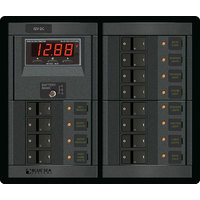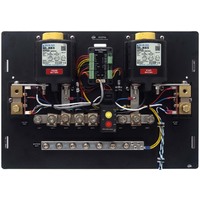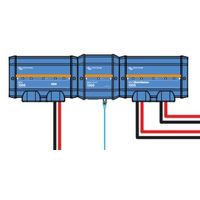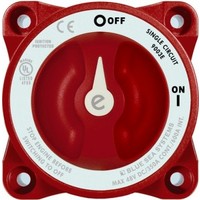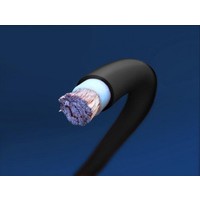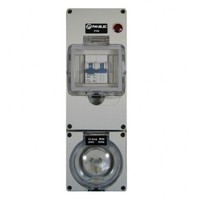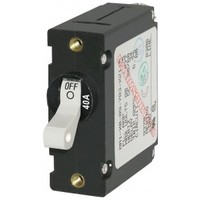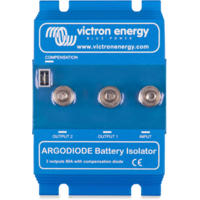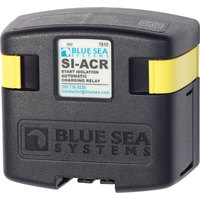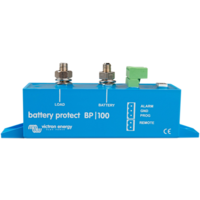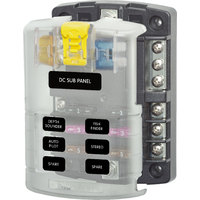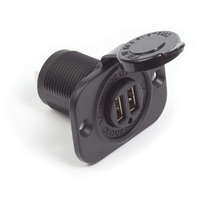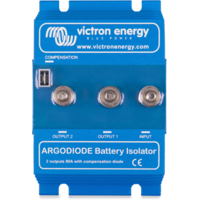Power Distribution
Electrical panels are at the core of an electrical system to provide switching and circuit protection.
- Choose a standard panel
- Design your own Blue Sea custom panel
- Have Outback Marine design and build a full custom panel
- Power input facility from batteries
- VE.CAN shunt for connection to monitoring system
- Fused busbar system for connection to loads
Battery switches isolate the potentially destructive energy in the battery banks when the boat is not in use or during emergencies.
Distribute AC power from shore power, inverter and generator sources using shore power inlets, galvanic isolators, isolation transformers, AC panels and distribution boards.
Battery isolators allow simultaneous charging of two or more batteries from one alternator, without connecting the batteries together.
Charging relays (also known as ACRs and VSRs) connect batteries for cross charging when a valid charging voltage is present on either battery.
A low voltage disconnect removes loads before they deplete the battery.
- Disconnect up to 220A
- Models with adjustable cutout voltages
Diode battery combiners are used to guarantee continuous DC power to mission critical equipment, such as an electronic engine control system.
Electrical System Design
Vessel electrical systems can range in complexity from a simple single battery system as found on an outboard motor powered trailer boat to a relatively complex system using multiple battery banks with sophisticated AC and DC power distribution arrangements. For individuals wanting to design and implement their own system, Outback Marine markets a broad range of specialised components required to build a total system from the simplest to the most complex.
An alternative is to select one of Outback Marine's factory configured electrical systems. The majority of power distribution components that are typically installed and wired on location at the vessel have been transferred to factory built sub assemblies - AC and DC power distribution boards. Combined with Outback Marine electrical panels, the distribution board architecture simplifies the application to a set of functional blocks with straight forward interconnection wiring.

We expect this approach to be considerably less expensive then the component alternative when taking into account the total cost including labour and parts of a complete installation. Moreover, our planned system design of the overall job quickly identifies the client expectations and associated cost which means that our clients are not confronted with creeping costs. As the more sophisticated marine components are embedded onto our distribution boards and electrical panels, less specialised electrical trades people can effectively produce a professional result.
The block diagram above is indicative of a system that would be suitable for a live aboard vessel equipped with genset, house batteries, air conditioning, inverter charger, engine charging, solar panels and so on. Although tailored for a cruising catamaran, most system elements will transfer to other styles of vessel. Elements of the following description can be equally applied to other vessel configurations.
AC Power Sources
AC power can be sourced from the dock (shore power), an on board generator or an inverter (inverter-charger).
For AC power away from the dock, an inverter will transform DC battery power to 240 volt AC power suitable for many common appliances. For continuous loads of a relatively higher power rating (as in the case of air conditioning), a generator set will be required to meet the demand. None the less, an inverter is still common in generator set systems as it can provide short term power or low power needs without starting the genset. Examples might be for powering a television set or heating a cup of soup in a microwave oven.
AC Power Distribution
The AC distribution board handles the input switching of the appropriate AC power source and distribution of AC power to and from the AC House Panel. An important function of the AC board is to test the incoming polarity of the shore power connection and only make a connection if it is correct.
The AC House Panel has metering to monitor the characteristics of AC power, incorporates a source select switch to select the source of AC power and has a set of circuit breakers to control power for each of the AC power circuits. These switched circuits return to the AC distribution board for subsequent wiring of active, neutral and earth to the powered AC devices.
DC Power Sources
The main DC power source of a vessel is the battery bank. It has a very high current capacity to support engine starting and is capable of sustaining continuous loads without having to run an engine or a generator. But as a battery it also needs charging.
For inboard powered boats, the engine alternator is a powerful charging source. A specialised external alternator regulator maintains the correct alternator charging output by closely monitoring battery temperature and adjusting the charging voltage to obtain the fastest safe charging level.
An AC Genset provides AC power which in turn through a battery charger can be used for battery charging. It's important to match the battery charger to generator output power.
Solar panels can play a major role in battery charging provided that sufficient space is available to mount the required number of panels. As a minimum, a single panel is ideal to hold a maintenance charge while the vessel is left unattended.
Battery charging can be a simple process but also a dangerous one if the system is not correctly designed. In any case, a common objective is to minimise engine run time.
DC Power Distribution
The DC Power Distribution board is central to most DC components of the vessel. The first responsibility is to manage battery connection and isolation. The ability to completely isolate batteries in case of a fire or other emergency is a fundamental requirement of vessel safety. In the system shown, all power on the vessel is sourced from a House Battery. A Reserve Battery is available for essential services such as communications and engine starting if the need ever arises.
Power to engines, inverter charger and electrical panels is provided by bus bar mounted fuses that protect the heavy vessel cables from fire damage in the event of a short circuit. The electrical panels have circuit breakers that perform double duty. They provide circuit overload connection and act as a switch for controlling power to each device circuit.
The DCD also contains detail circuitry used in power monitoring and control. A battery monitor and optional remote battery switch control functions are included on one of the DC Electrical panels.
Circuit breaker panels complete the DC power distribution picture. While they enable individual load circuits to be turned on and off, their primary function is to protect the wire connecting to the load device by limiting current in case of an overload condition.

